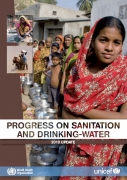 This report by WHO and UNICEF, describes the global status and trends with respect to the use of safe drinking water and basic sanitation, and global progress made towards the Millennium Development Goals (MDGs) in the context of drinking water and sanitation targets. The findings reveal some striking disparities with respect to:
This report by WHO and UNICEF, describes the global status and trends with respect to the use of safe drinking water and basic sanitation, and global progress made towards the Millennium Development Goals (MDGs) in the context of drinking water and sanitation targets. The findings reveal some striking disparities with respect to:
- the gap between progress in providing access to drinking water versus sanitation
- the divide between urban and rural populations in terms of the services
- the differences in the way different regions are performing
- disparities between different socio-economic strata in the society
- gendered differences in the burden experienced in accessing and collection of drinking water
The report also presents and highlights the drinking water and sanitation situation in India, one of the most populous countries from South Asia, which has the greatest number of people without sanitation facilities, globally. Figures indicate that open air defecation continues to be practised the most in South Asia (64%), but has shown a decreasing trend from  66% in 1990 to 44% in 2008.
66% in 1990 to 44% in 2008.
The number of people practising open air defecation are found to be maximum in India. However, recent trends indicate that the situation is improving with 31% of the population in 2008 using improved sanitation facilities as compared to 18% in 1990 and 88% of the population in 2008 using drinking-water from improved sources as compared to 72% in 1990.
The report provides statistical data from different countries including developing countries such as India, on the current situation with respect to access to drinking water and sanitation.
The full copy of the report can be downloaded from the World Health Organisation (WHO) website.
/articles/progress-sanitation-and-drinking-water-report-who-and-unicef-2010